Simion Cernica (born in Bucharest) lives and works in Los Angeles since 2011. Subversion and language practice are the valued practices of philosophical, aesthetic investigation and critical resistance, developed by exploring the actual socio-politic and cultural dynamics. By questioning the accepted cultural views that are mainstream, his aim is to critically challenge how we perceive reality, cultural history, and how we promote our fragile humanity. His art maintains an “Arte Povera” direction, proposing speculative updates and avant-garde possibilities in contemporary settings.
At the beginning of 2023, Simion comes back to Romania, at The H Gallery (Calea Victoriei 109) with “Unplugged Cave”, a solo exhibition in which he ironically deconstructs the relationship we have with images, in a reality processed by devices and media. What follows is a detailed discussion on the artist’s specific interests and modes of working.
As a Romanian artist based in LA, do you think that this geographical transition has become visible in your art, as well? Was there a specific moment of stylistic shift or was the path rather organic?
My geographical relocation was quite “extreme”, from one edge of the cultural West to the other, or, you could say, from one border to the other. Of course, the cultural crash and especially the adjustment to the new life as an emigrant, a self-exile, loaded my critical system and slowed down my processes and ability to make art. In short, the change became gradually visible in my practice, but not through that “stylistic shift”; my style was no longer my base criterion, but it was a restructuring/adjustment coming from within. It wasn’t exactly easy, but it was necessary, perhaps organic in my own way of making art and being correct with myself.
There is obviously a considerable gap in the production, dissemination/exhibition, and overall consumption of art in America vs. in Eastern Europe. Mainly, the mindset of the public is totally different in these cases, especially in the present period when the PC trend is increasingly infiltrating the creative/artistic area. How do you manage to bring social/civic charged messages to the forefront without taking a concrete political/activist stance?
Above all, I’m an artist. Art is my main “subject”, with and through which I (often) seek to also introduce a “message” (be it political, philosophical, poetic, ecological, etc). I don’t necessarily aim for activism when I make art, and if the civic/social/political message, etc. exists and if I want it to be “visible”, then it will be part of the subject matter of the work itself, without it being obvious. It is an assumed message, but with my means, those of the visual artist, without pretending to do more than that. In short, it is more of an exercise in the lexicon, in expanding the vocabulary of art, towards the areas I am interested in exploring… And the public reads it as it will, with the gaps or advantages of reception, with the specific biases of the space in which it lives. Let’s not forget that we are contemporaries with the inflation of influencers, doing a lot of activism, trending brands on social and community oriented, climate awareness etc. Likewise, we have more artists and cultural agents, with access to resources, proposing or practicing activism, often only in a populist way. So, we have more and more activism, widespread in many democracies. However, we still cannot have a coherent, common voice, in line with the decision-making entities in today’s societies. Let the artists save the planet while the rest of us are busy; “Time is money”.
Have you ever received such an artistic interpretation (in a political key) that tries to put you in a dichotomous “us vs. them” pattern?
Yes, it happened, and it will happen again. As an artist, you are easily “profiled”, sometimes just from snippets, from “stuff” easily found online, on social media, or from gossip these days. So is your work read without perspective, taken out of context, just like your approach. Rather, I have become a kind of “self vs. them”, and I am really interested in forms of personal (artistic) resistance, but I also had to adapt, to take this on. To answer the question above (about the political/activist stance), people forget something “politically funny”: where they come from (Romania). More recently, I’ve become exotic whenever I come back to do projects, and, where I’ve come to live (California), I’m no longer perceived as exotic/cool, precisely because I come from a geographic area that now is not very culturally or commercially interesting here. And the critical emphasis plus (my) subversive exercise, applied to each individual location, is not easy to digest no matter the place. Just like personal ecology or that of the artistic approach: if it is assumed, it can also become a political attitude. This is also the kind of art and political attitude that is of interest to me. But reality shows us that successful art, more or less political, is not really appreciated immediately unless it can be capitalized on, propagandistically or commercially.
One interesting thing is that you choose to still come back to Romania for exhibitions, both in the context of galleries and art festivals (such as the Art Encounters Biennial in Timisoara). Do you have any set criteria or strategies according to which you choose exhibition locations?
I have criteria, strategies and preferences, but they rarely overlap with whatever happens in the realities of the two artistic worlds I am part of. By chance or not, I have had more exhibition invitations overlap with my criteria in Romania. I won’t go into much detail, but whether you are a peripherally born artist or an immigrant artist, the truth is that you don’t really have options. In addition to that, there is also my way of working and creating art often, from outside the system, with “punk-poetic” methods, so it’s not exactly the easy way.
Your latest solo exhibition is at The H Gallery, which opened on the 13th of January. How does Unplugged Cave fit conceptually, given your other recent exhibitions in Romania? Are there any common features?
In Unplugged Cave, like in other exhibitions where I have conceptual control, I suggest the approach that interests me, while taking into account the physical and budget limitations. At the same time, I use more or less the same methods (dogmas) of exhibition construction, I include new/never-shown works that can articulate what I want to say, and/or older pieces in case they make sense to be shown now, but also works made specifically for that exhibition. Similarly, I take into account the specificity of the geographical location, of the exhibition space, I look for specific, local “energies” and materials, I bring things made far away (transatlantic), but I also create new pieces on the move. Most importantly, I don’t stray from the project’s conceptual trajectory and artistic integrity.
You mentioned in a previous meeting that you aim to recreate in Unplugged Cave a kind of “concept store-like” experience, ironically. To what extent does this commercial detail contribute to the conceptual construction of the exhibition?
Working with space, the general choreography, the balance between exhibits, “the site-specific reading”, they are all very important to me in an exhibition, especially if it is a solo one. So, I always seek to find ways of exhibiting/display for the chosen pieces. And the parallel between the “clean” gallery space (that white cube) and a concept store, an “Apple store” or some other kind of contemporary chic dream and object store, comes naturally. I’m more interested in a critical exercise, soft yet now double-edged, towards such displays and tricks to “steal” attention. Art can mimic such a “refined” experience for purposes that are other than commercial, it can be slightly subversive through a simple arrangement of objects in the exhibition space. A space like the ones above, an aseptic one, but in which we now find, instead of typical products, other materializations, another intention. At the same time, the concept store is also one of the newest and most popular forms of the cave to which the human species has “progressed” so far. No more shop windows!
At the same time, in Unplugged Cave there is a kind of “nostalgic” resignation, through the prism of old devices that become, strangely enough, relics of the contemporary period. What is the relationship between these ready-made accents and the abstract context of the paintings exhibited in tandem?
The devices and accessories, which are integrated parts of the sculptures, carry those material “accents” of present or immediate past history. Nostalgia is in the eye of the beholder. So perhaps is the fetish/attachment/resignation they carry for them. Devices are part of our contemporary lives, full of objects and accessories from different generations, and technology generations are often changing against our will, at an increasingly rapid pace. Painting, even if it is a much older medium, can also be relevant today. Painting can still bear actuality if that is what the artist seeks. The paintings in the exhibition are part of my current practice, and I wanted to engage in this topical game/relationship with sculptures and objects of the same “generation”. Paintings are always “Unplugged”. The advantage of an old yet not outdated medium is, most of the time, how it doesn’t expire and how it doesn’t become “obsolete” so quickly.
Coming back to the painting, it is worth noting the way the compositions vary between geometry and gestures. An ever-present entity seems to be the circle/sphere. Given your background in the study of physics and mathematics, is it fair to say that the area of exact sciences has an influence on the composition of the works? If so, what are the principles that you aim to specifically portray? Or is it perhaps a purely aesthetic choice?
Well noticed, in the medium and large paintings in the exhibition, the circle appears over and over again, mainly because it is drawn from an extended series of Chemical Sunset, but not exclusively. The circle is an essential, primordial, organic geometric form with particular aesthetic power, which I am interested in bringing to work, always careful to integrate it into the compositional and conceptual fabric of the work, of course. In the case of these works, the specific is an intention of an aesthetic and conceptual fit. They are both counterpoint and music, the latter being an important part of the post-industrial, punk-poetic (perhaps even post-human) atmosphere I seek through painting. Of course, I’ve already said that I’m also looking very closely at the conceptual, abstract side, which paves the way for the theories of the exact sciences (plus the idea of music as auditory mathematics represented visually) – all aesthetically filtered.
Another reference might be chromatics, not only in the visual dimension but also in the actual material properties that are perceived through the interaction between media. Red, yellow and blue, the three primary colors, generally prevail. How do you control the strong visual impact they have?
That’s right. I tend to use primary colors, but I try not to set it as a fixed dogma or a “trademark”. I’m very interested in how the primary colors blend, dilute, dematerialize and transform as the work progresses. I am interested in capturing the boundary between the purity of color and the incipient layers of combination.
The visual impact control is the hardest for me too, mainly because I never have it set up beforehand. It varies in every instance of the entire creative process, which I have refined over time through various exercises and, most crucially, through direct work. On the shield, in any work I complete, chromatics is very important precisely because it largely guides my creative process without ever remaining the only direction pursued as a norm.
The series of small works is called Blockchain. Is this a reference to blockchain in its essential algorithmic sense for NFTs and crypto currency?
I chose the word “Blockchain”, but not just as a technical reference rather as a “poetic” one. In a way, it’s a critical reference that wants to associate these abstract works with a historical actuality, with a trend and with the time when they were produced. My process of working with abstract painting is based on such references to current media reality, subversively reconstructing them. I chose to take advantage of the “freshness” of the serial works, produced in 2022 – a year in which we witnessed, among other things, the bursting of the NFT financial bubble, but also the claim of the new cultural guru-managers that Blockchain will immediately offer us, among other things, solid solutions to the dysfunctions of current cultural practices.
Since The H Gallery is a new gallery, freshly opened in 2022, how did you manage the risks of such a collaboration?
The possibility of incompatibilities and “risks” in a new collaboration always exists, whether the space is newly opened or a long-established one. However, in the local context (in Romania), I find it easier to overcome the possible awkwardness or insecurities of collaborating with a new space, and I even deliberately seek to collaborate with new spaces/entities that come with more sincerity and timeliness, while being less tainted by cultural politics, power plays, or other early obstacles.
Lastly, can you say something about future projects? What comes after Unplugged Cave?
To put it in perspective, Unplugged Cave is a solo/personal gallery exhibition built exclusively with recent works. All these series (of painting, object/ sculpture/ installation, “protest marks”) will continue to evolve in my lab, among other projects. Most of my projects have many common conceptual threads, dissemination, and production modes, working dogmas, etc. On another note, I plan to start working on a serial performance project, which I’ve been putting off; I plan to look over video and photo material I’ve made over the past few years (which I haven’t shown publicly). And, of course, I plan to keep “expanding the cave”, to also find the right resources, to participate circumspectly and subversively, in the contemporary cultural (commons) adventure. I plan to make art actual.
Simion Cernica’s solo show, Unplugged Cave, took place in Bucharest at The H Gallery during 13.01 – 16.03.2023.
Translated by Liliana Popescu
POSTED BY
Tea Vindt
Tea is studying art history at the National University of Arts in Bucharest. After graduating from Tudor Vianu National College of Informatics, her path became more and more artistic as she first star...


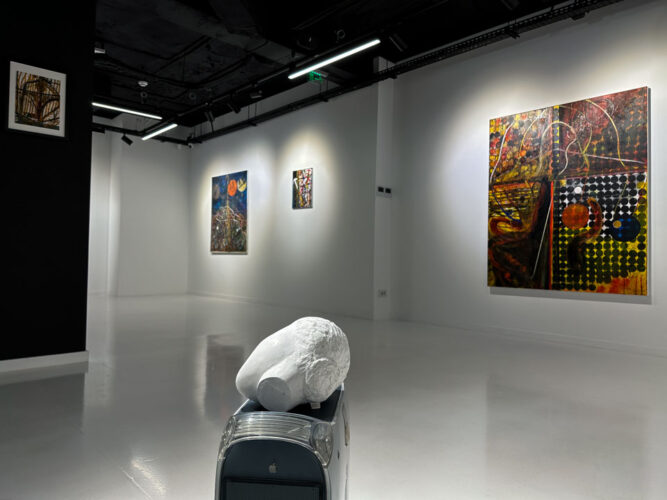
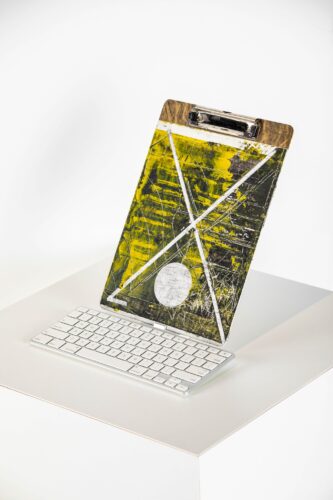
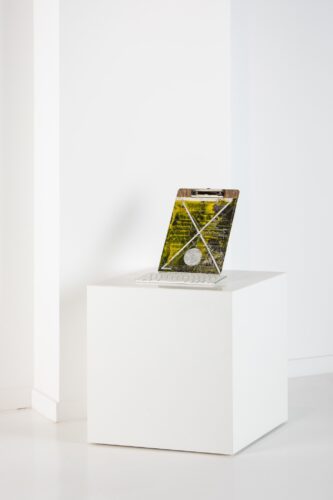
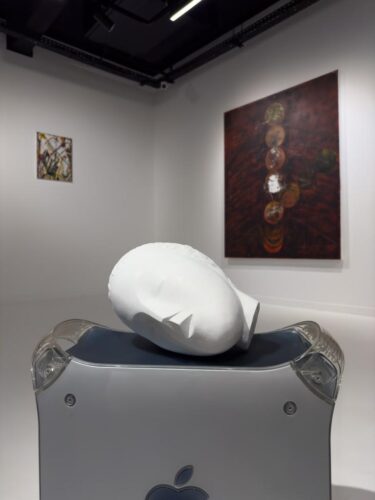
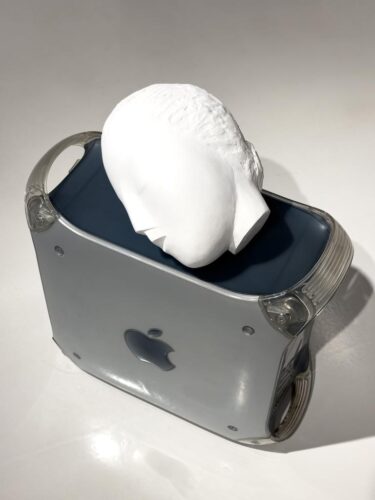
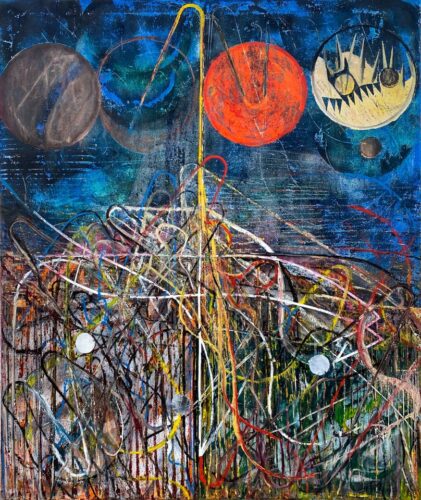
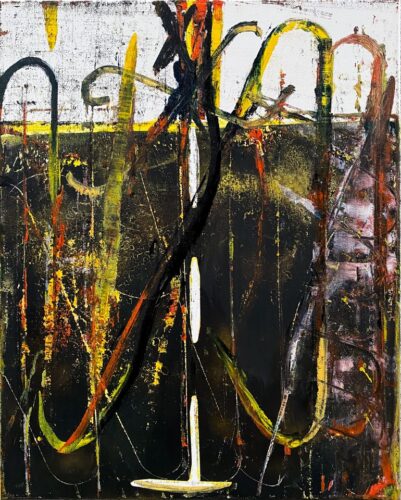
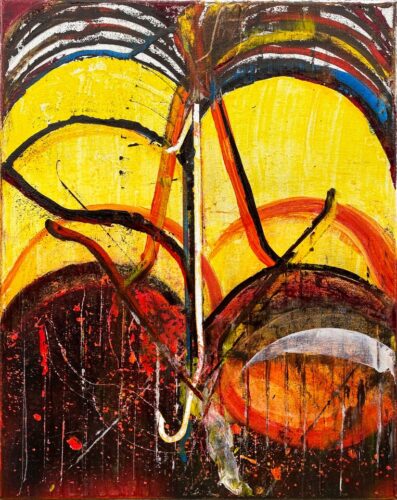
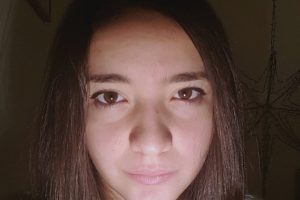
Comments are closed here.